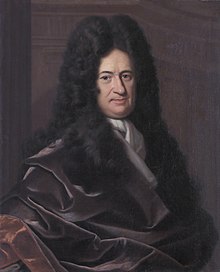Nonstandard analysis
The history of calculus is fraught with philosophical debates about the meaning and logical validity of fluxions or infinitesimal numbers.Nonstandard analysis[1][2][3] instead reformulates the calculus using a logically rigorous notion of infinitesimal numbers.[4][5] He wrote: ... the idea of infinitely small or infinitesimal quantities seems to appeal naturally to our intuition.As for the objection ... that the distance between two distinct real numbers cannot be infinitely small, Gottfried Wilhelm Leibniz argued that the theory of infinitesimals implies the introduction of ideal numbers which might be infinitely small or infinitely large compared with the real numbers but which were to possess the same properties as the latter.Robinson argued that this law of continuity of Leibniz's is a precursor of the transfer principle.Robinson continued: However, neither he nor his disciples and successors were able to give a rational development leading up to a system of this sort.[6]Robinson continues: ... Leibniz's ideas can be fully vindicated and ... they lead to a novel and fruitful approach to classical Analysis and to many other branches of mathematics.Robinson's original approach was based on these nonstandard models of the field of real numbers.[8] On page 88, Robinson writes: The existence of nonstandard models of arithmetic was discovered by Thoralf Skolem (1934).Skolem's method foreshadows the ultrapower construction [...]Several technical issues must be addressed to develop a calculus of infinitesimals.The challenge of developing a consistent and satisfactory theory of analysis using infinitesimals was first met by Abraham Robinson.H. Jerome Keisler, David Tall, and other educators maintain that the use of infinitesimals is more intuitive and more easily grasped by students than the "epsilon–delta" approach to analytic concepts.Another pedagogical application of nonstandard analysis is Edward Nelson's treatment of the theory of stochastic processes.Both of these approaches apply to other areas of mathematics beyond analysis, including number theory, algebra and topology.Robinson's original formulation of nonstandard analysis falls into the category of the semantic approach.Since Robinson's work first appeared, a simpler semantic approach (due to Elias Zakon) has been developed using purely set-theoretic objects called superstructures.Nelson introduced an entirely axiomatic formulation of nonstandard analysis that he called internal set theory (IST).Syntactic nonstandard analysis requires a great deal of care in applying the principle of set formation (formally known as the axiom of comprehension), which mathematicians usually take for granted.Abraham Robinson and Allen Bernstein used nonstandard analysis to prove that every polynomially compact linear operator on a Hilbert space has an invariant subspace.[16] Given an operator T on Hilbert space H, consider the orbit of a point v in H under the iterates of T. Applying Gram–Schmidt one obtains an orthonormal basis (ei) for H. Let (Hi) be the corresponding nested sequence of "coordinate" subspaces of H. The matrix ai,j expressing T with respect to (ei) is almost upper triangular, in the sense that the coefficients ai+1,i are the only nonzero sub-diagonal coefficients.Bernstein and Robinson show that if T is polynomially compact, then there is a hyperfinite index w such that the matrix coefficient aw+1,w is infinitesimal.Then the space of all standard elements infinitely close to Ej is the desired invariant subspace.Upon reading a preprint of the Bernstein and Robinson paper, Paul Halmos reinterpreted their proof using standard techniques.Nonstandard analysis was used by Larry Manevitz and Shmuel Weinberger to prove a result in algebraic topology.Among the list of new applications in mathematics there are new approaches to probability,[11] hydrodynamics,[21] measure theory,[22] nonsmooth and harmonic analysis,[23] etc.There are also applications of nonstandard analysis to the theory of stochastic processes, particularly constructions of Brownian motion as random walks.[24] As an application to mathematical education, H. Jerome Keisler wrote Elementary Calculus: An Infinitesimal Approach.Despite the elegance and appeal of some aspects of nonstandard analysis, criticisms have been voiced, as well, such as those by Errett Bishop, Alain Connes, and Paul Halmos.The working view of nonstandard analysis is a set *R and a mapping * : V(R) → V(*R) that satisfies some additional properties.We now formulate the basic logical framework of nonstandard analysis: One can show using ultraproducts that such a map * exists., This is useful, for instance, in a topological space X, where we may want |2X|-saturation to ensure the intersection of a standard neighborhood base is nonempty.
Gottfried Wilhelm Leibnizinfinitesimalshistory of calculusfluxionsinfinitesimallimitsAbraham Robinsonlaw of continuitytransfer principlemodel theoryintuitionistArend Heytingordered fieldabsolute valuenon-Archimedeananalysisnonstandard modelsreal closed fieldThoralf SkolemultrapowersemiringultrafilterFréchet filterNewtonGeorge BerkeleyDetlef Laugwitzzero divisorsH. Jerome KeislerDavid TallEdward Nelsonstochastic processesSergio Albeveriosemanticmodel-theoretic approachsaturated modelstheorysuperstructurescountableinternal set theoryZermelo–Fraenkel set theoryaxiom of comprehensionVopěnka's alternative set theoryAugustin-Louis CauchyCours d'Analyselinear operatorHilbert spaceinvariant subspacePaul Halmosindividual ergodic theoremAlex WilkieGromov's theorem on groups of polynomial growthShmuel WeinbergerBrownian motionrandom walksmathematical educationnonstandard calculusstandard partCriticism of nonstandard analysisErrett BishopAlain Connespower setisomorphicseparablemetric spacesmetrizable topological vector spacesformulabounded quantificationuniversally quantifiedexistentially quantifiedhyperreal numbersmicrocontinuitysaturationif and only ifhyperintegerDehn planeDedekind cutssaturatedfinite intersection propertyneighborhood baseCalculus Made EasyConstructive nonstandard analysisHyperfinite setHyperreal numberInfluence of nonstandard analysisNonstandard modelNonclassical analysisOverspillSmooth infinitesimal analysisSurreal numberPeter A. LoebWayback MachineJoseph W. DaubenRobinson, A.Israel Journal of MathematicsCutlandKutateladze S. S.Robert GoldblattGraduate Texts in MathematicsRobert, A.Fundamenta MathematicaeStroyan, K.Tao, T.AdequalityLeibniz's notationIntegral symbolThe AnalystThe Method of Mechanical TheoremsCavalieri's principleSynthetic differential geometryInfinitesimal strain theory (physics)DifferentialsDual numbersSurreal numbersStandard part functionIncrement theoremInternal setLevi-Civita fieldTranscendental law of homogeneityPierre de FermatLeonhard EulerAnalyse des Infiniment Petits